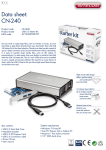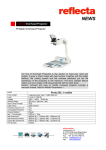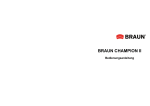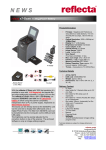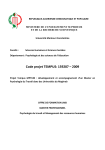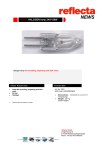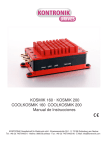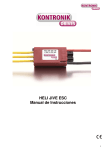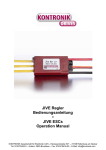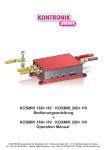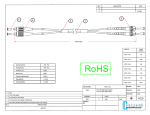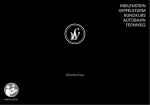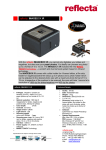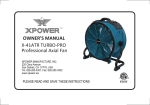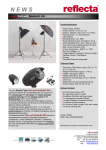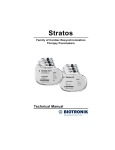Download OPERATING INSTRUCTIONS SPARE PARTS LIST
Transcript
GE N ERAL PACKING INSTRUCTIONS SPARE PARTS LIST OPERATING INSTRUCTIONS BITZER KÜHLMASCHINENBAU GMBH BETRIEBSANLEITUNG ERSATZTEILLISTE LISTE DES PIÈCES DÉTACHÉES SCHKEUDITZ GMBH INSTRUCTION DE SERVICE BITZER KÜHLMASCHINENBAU Version 1.0 SE-160-4 KB-540-3 Contents Page 1. Objective and purpose of the instructions . . . . . . . . . . . . . . . . . . . . . . . . . . . . . . . . . . . . . . . . 2 2. Scope and legal relevance . . . . . . . . . . . . . . . . . . . . . . . . . . . . . . . . . . . . . . . . . . . . . . . . . 2 3. Acceptable loading equipment and correct use 3.1 Europallets and mesh box pallets . . . . . . 3.2 Small load carrier . . . . . . . . . . . . . . . 3.3 Disposable packaging . . . . . . . . . . . . 4. Loading units . . . . . . . . . . . . . . . . . . . . . . . . . . . . . . . . . . . . . . . . . . . . . . . . . . . . . . . . 4 4.1 Stackability . . . . . . . . . . . . . . . . . . . . . . . . . . . . . . . . . . . . . . . . . . . . . . . . . . . . . . . 4 4.2 Load securing . . . . . . . . . . . . . . . . . . . . . . . . . . . . . . . . . . . . . . . . . . . . . . . . . . . . . 5 5. Technical condition of packaging . . . . . . . . . . . . . . . 5.1 General . . . . . . . . . . . . . . . . . . . . . . . . . . . 5.2 Cleanliness of Kanban and returnable containers . . . . . 5.3 Exchangeability of loading equipment . . . . . . . . . . . 5.4 Examples for non-exchangeable Europallets . . . . . . . 5.5 Examples for non-exchangeable wooden stacking frames 5.6 Examples for non-exchangeable EURO mesh boxes . . . 6. Completeness of delivery documents . . . . . . . . . . . . . . . . . . . . . . . . . . . . . . . . . . . . . . . . . . . 9 7. Identification and labeling . . . . . . . 7.1 General . . . . . . . . . . . . . . . 7.2 Labeling of packing pieces . . . . . 7.3 Delivery of batches . . . . . . . . . 7.4 Handling symbols . . . . . . . . . . 7.5 Symbols for hazardous substances 7.6 Storage symbols . . . . . . . . . . . . . . . . . . . . . . . . . . . . . . . . . . . . . . . . . . . . . . . . . . . . . . . . . . . . . . . . . . . . . . . . . . . . . . . . . . . . . . . . . . . . . . . . . . . . . . . . . . . . . . . . . . . . . . . . . . . . . . . . . . . . . . . . . . . . . . . . . . . . . . . . . . . . . . . . . . . . . . . . . . . . . . . . . . . . . . . . . . . . . . . . . . . . . . . . . . . . . . . . . . . . . . . . . . . . . . . . . . . . . . . . . . . . . . . . . . 10 . 10 . 10 . 11 . 11 . 11 . 12 8. Packaging of hazardous materials . . . . . . . . . . . . 8.1 General . . . . . . . . . . . . . . . . . . . . . . . . 8.2 Special requirements for wooden packing materials . 8.3 Forbidden materials . . . . . . . . . . . . . . . . . . . . . . . . . . . . . . . . . . . . . . . . . . . . . . . . . . . . . . . . . . . . . . . . . . . . . . . . . . . . . . . . . . . . . . . . . . . . . . . . . . . . . . . . . . . . . . . . . . . . . . . . . . . . . . . . . . . . . . . . . . . . . . . . . . 12 . 12 . 12 . 12 9. Corrosion protection of the goods . . . . . . . . . . . . . . . . . . . . . . . . . . . . . . . . . . . . . . . . . . . . . 12 9.1 General . . . . . . . . . . . . . . . . . . . . . . . . . . . . . . . . . . . . . . . . . . . . . . . . . . . . . . . . . 12 9.2 VCI packaging . . . . . . . . . . . . . . . . . . . . . . . . . . . . . . . . . . . . . . . . . . . . . . . . . . . . . 12 . . . . . . . . . . . . . . . . . . . . . . . . . . . . . . . . . . . . . . . . . . . . . . . . . . . . . . . . . . . . . . . . . . . . . . . . . . . . . . . . . . . . . . . . . . . . . . . . . . . . . . . . . . . . . . . . . . . . . . . . . . . . . . . . . . . . . . . . . . . . . . . . . . . . . . . . . . . . . . . . . . . . . . . . . . . . . . . . . . . . . . . . . . . . . . . . . . . . . . . . . . . . . . . . . . . . . . . . . . . . . . . . . . . . . . . . . . . . . . . . . . . . . . . . . . . . . . . . . . . . . . . . . . . . . . . . . . . . . . . . . . . . . . . . . . . . . . . . . . . . . . . . . . . . . . . . . . . . . . . . . . . . . . . . . . . . . . . . . . . . . . . . . . . . . . . . . . . . . . . . . . . . . . . . . . . . . . . . . . . . . . . . . . . . . . . . . . . . . . . . . . . . . . . . . . . . . . 2 2 3 3 6 6 6 6 6 7 8 10. Empties . . . . . . . . . . . . . . . . . . . . . . . . . . . . . . . . . . . . . . . . . . . . . . . . . . . . . . . . . . . 13 10.1 Return of empties . . . . . . . . . . . . . . . . . . . . . . . . . . . . . . . . . . . . . . . . . . . . . . . . . . . 13 10.2 Exchange of empties . . . . . . . . . . . . . . . . . . . . . . . . . . . . . . . . . . . . . . . . . . . . . . . . . . 13 11. Handling of defective packaging . . . . . . . . . . . . . . . . . . . . . . . . . . . . . . . . . . . . . . . . . . . . . . 13 List of abbreviations . . . . . . . . . . . . . . . . . . . . . . . . . . . . . . . . . . . . . . . . . . . . . . . . . . . . . . . 14 List of figures . . . . . . . . . . . . . . . . . . . . . . . . . . . . . . . . . . . . . . . . . . . . . . . . . . . . . . . . . . . 14 List of tables . . . . . . . . . . . . . . . . . . . . . . . . . . . . . . . . . . . . . . . . . . . . . . . . . . . . . . . . . . . 14 The companies defined under “Scope” are in the following referred to as “BITZER”. All suppliers who maintain business relations with these companies are in the following referred to as “Supplier(s)”. 1. Objective and purpose of the instructions As a continuously growing company, BITZER faces the important task of optimizing increasing material streams both internally as well as in deliveries with other companies. A standardized packaging agreed upon with the supplier offers significant potential for an optimized organization of the goods receipt process. This will ensure that our storage system is able to promptly process supplied goods without any avoidable additional expenses caused by repacking, additional controls, new identification, shifting, or disposal of the goods. 2. Scope and legal relevance The general packing instructions are applicable to all deliveries to BITZER Kühlmaschinenbau GmbH, including the plants Rottenburg-Hailfingen and Rottenburg-Ergenzingen, and to BITZER Kühlmaschinenbau Schkeuditz GmbH. Specifics regarding the packaging will be agreed with BITZER in written form in special material-related packing instructions. Any special agreements regarding packaging previously entered into with BITZER remain valid. Any changes regarding packaging, whether relating to packaging or to packing units, require the prior written approval of BITZER’s materials management. BITZER’s approval of packaging independently chosen by the supplier and of any changes effected by him will not affect the supplier’s liability for faulty packing and any resulting transport damages. In the case of deliveries that are not related to intra-Community trade, the supplier shall obtain information about the packing instructions and mandatory documents valid in the relevant country and adjust the packing to the existing conditions. In the case of noncompliance with the general packing instructions, BITZER reserves the right to return the goods or to charge the resulting additional expenses for the goods receipt process to the supplier’s account. The compliance with the legal and contractual regulations with regard to packing exclusively rests with the supplier. The same also applies to the compliance with packing regulations under public law. If a provision of these instructions is found to be ineffective in whole or in part, or if it will be found ineffective in future, the validity of the remaining provisions shall remain unaffected thereby. The ineffective or unenforceable provision is to be replaced by an effective and enforceable provision whose spirit and purpose comes closest to the void provision. 3. Acceptable loading equipment and correct use Specific packaging is to be agreed individually with the supplier. As a basic principle, the thickness of the wood used for cases, crates, and carriages has to be adjusted to the weight, the sensitivity, the position of centre of gravity, the value of the goods, as well as to the expected strain related to transport, handling, and storage. The following standardized loading equipment is to be used for all deliveries that are not regulated by the item “Specific packaging”. 3.1 Europallets and mesh box pallets • • • • • • Pallets according to DIN 15141-Part 4 or DIN 15146-Part 2 Mesh box pallets according to DIN 15155 Poolability Stackability The use of auxiliary material (e. g. plastic corners) is recommended No overlapping of longitudinal and transverse sides of the cargo over the edges of the loading equipment in Europallets and mesh box pallets • Even load spreading on loading equipment Total gross weight (max.) Maximum dimensions (L x W x H) Rottenburg Schkeuditz 950 kg 800 kg 1200 x 800 x 1400 mm 1200 x 800 x 1650 mm Table 1: HRL data 2 Version 1.0 Figure 1: Europallet Figure 2: EURO Mesh Box Pallet 3.2 Small load carrier • • • • • • Modularly adjusted to Europallet Poolability Stackability If possible closed with a cover Total gross weight 20 kg max. Dimensions according to SSI-Schäfer specification: Material numbers EF 6150, EF 6220 and EF 6420 Figure 3: SSI-Schäfer returnable container 3.3 Disposable packaging The choice of packaging should generally be made according to the quantity to be delivered. That is, a delivery should not be split into a multitude of individual parcels, but preferably be combined and delivered on one Europallet. Version 1.0 3 Disposable packaging should be avoided as far as possible, in order to minimize the environmental burden. If disposable packaging (e. g. cardboard boxes) is still used, it should not exceed the basic measurements defined in Table 2. This renders the option to store disposable packaging modularly adjusted to the Euro measure. An environmentally sound recovery is to be ensured for disposable as well as for reusable packaging. Total gross weight (max.) 20 kg Maximum dimensions (L x W x H) 550 x 350 x 400 mm Table 2: Maximum dimensions for disposable packaging 4. Loading units 4.1 Stackability Loading units have to be combined in such a way that they may be handled, transported, stacked, and stored as a unit. If loading units consist of smaller containers, they have to be adjusted to the standard measurements of the pallets. A maximum of 4 different material numbers, correctly sorted side by side, visibly separated by interlayers (never stacked), may be commissioned as a loading unit. It should be noted that similar items may not be located in the same loading unit, in order to avoid mistakes and false entries. correct wrong Figure 4: Stackability wrong wrong correct Figure 5: Loading 4 Version 1.0 4.2 Load securing The packaging should always be chosen in such a way that load securing may be effected without any difficulty. This avoids any shifting of and damages to the goods during transport. This may be achieved by using shrink hoods, straps, and stretch film. The cutting of straps into cardboard packaging must be avoided by the use of edge protection profiles. Wooden stacking frames must be used to secure stacked cargo against shifting. The technically flawless condition of stacking frames is to be assured by the sender. In the case of withdrawals of partial quantities from a loading unit, the stability of the remaining quantity must be ensured. The possibility to handle the cargo by means of conveyor systems and automatic materials handling equipment must be guaranteed by sufficient space between the pallet bases. No interference may be caused by the securing of loading units. wrong correct Figure 6: Load Securing Stacked goods are to be delivered in the specified quantity unit, with an appropriate packaging agreed upon with BITZER. Stacked merchandise is to be stacked in the package and to be secured in such a way that no shifting or any other movement of the components may occur during transport and general handling. Bulk goods are to be delivered in the specified quantity unit, with an appropriate packaging agreed upon with BITZER. Components with sensitive surfaces (e. g. faces, profiles) that are susceptible to damages caused by compressive stress may not be delivered as bulk goods. Bundled goods must be packed correctly sorted and secured against shifting. In order to avoid any bending of material sold by the meter (e. g. tubes) during transport, the goods to be conveyed must be adequately stabilized with squared timber. To guarantee a proper handling with lifting devices, the bundle should either be provided with straps or underlain with rectangular blocks of wood. When transporting tubes, the openings are to be closed with matching protective caps. Stacked goods Bulk goods Bundle Figure 7: Arrangement in Layers Version 1.0 5 5. Technical condition of packaging 5.1 General Packaging must protect from humidity, dirt and dust. Carriers – in particular the areas of contact with the material – must be in a clean and technically flawless condition. Used packaging aids (e. g. cardboard boxes, films, etc.) may not be used, since they may exhibit damages. 5.2 Cleanliness of Kanban and returnable containers The supplier has to take care that the loading equipment used by him – in particular returnable containers – are not contaminated with preservatives, oils, or other foreign substances. If contaminated Kanban and returnable containers are delivered, BITZER reserves the right to have them cleaned by a specialist or to arrange for their return at the supplier’s costs. 5.3 Exchangeability of loading equipment The exchangeability of loading equipment is regulated by the provisions of UIC bulletin 435-4. Non-exchangeable loading equipment will be separately recorded; it is not considered for exchange in the pallet statement. 5.4 Examples for non-exchangeable Europallets A board is missing Figure 8: Pallet 1 A log is missing or split, so that more than one nail is visible. Figure 9: Pallet 2 Bad general condition. E. g. brittle material, strong splintering, boards too thin, logs too narrow. The identification “EUR” on the right as well as the emblem of the Deutsche Bahn “DB” on the left are missing. Figure 10: Pallet 3 6 Version 1.0 A bottom or top edge board is splintered, so that more than one nail or screw shank is visible. Figure 11: Pallet 4 A board is broken diagonally or at a right angle. More than two bottom and top edge boards are splintered, so that more than one nail or screw shank is visible. Figure 12: Pallet 5 5.5 Examples for non-exchangeable wooden stacking frames The guiding pins are bent, so that there is an inappropriately large play in the fit of the frames and the load securing cannot be guaranteed. Figure 13: Frame 1 The steel dunnages are bent, so that a flush placing of the frames on top of each other is not possible anymore. Figure 14: Frame 2 Version 1.0 7 The dunnages are separated from the wood. A load securing is not present anymore. Figure 15: Frame 3 5.6 Examples for non-exchangeable EURO mesh boxes The emblem of the railway company or pallet organization and/or the emblem EUR (oval) are missing or illegible. Figure 16: Mesh box 1 The base frame or the feet are bent, so that the box pallet is not standing on its four feet anymore or cannot be stacked without any danger. A board is missing or broken. Figure 17: Mesh box 2 8 Version 1.0 The stacking frame or the corner posts are deformed. Figure 18: Mesh box 3 The round steel mesh is broken, so that the wire ends are extending into the box or protruding (one mesh per side may be missing). Figure 19: Mesh box 4 6. Completeness of delivery documents Deliveries are deemed to be completed when, in addition to the goods, all necessary delivery documents are available. • • • • Delivery note Bill of lading (e. g. CMR, Seaway Bill, Airway Bill) Packing list Product documentation The term “product documentation” includes test reports, declarations of conformity or specifications, for example. Any product documentation is to be sent previously by email (see Table 3). Place of delivery Documents to Rottenburg plant Hailfingen plant Schkeuditz plant [email protected] [email protected] [email protected] Table 3: E-mail accounts for documents Version 1.0 9 7. Identification and labeling 7.1 General Each consignment must be accompanied by a delivery note containing all relevant data: • • • • • • • • • • • Delivery note no. Delivery date Supplier Delivery address BITZER order number BITZER item number Material description Quantity Contact person/BITZER Number of packing pieces Batch number Delivery addresses are to be attached to the goods to be conveyed so that they are clearly legible. As far as different delivery addresses are present, no collective packaging may be used. Unless otherwise agreed, the following delivery addresses are valid for consignments to BITZER: Delivery address Goods receiving hours BITZER Kühlmaschinenbau GmbH Werk Rottenburg-Ergenzingen 7.00 a.m. to 3.50 p.m. Mercedesstraße 24 – 28 72108 Rottenburg Germany Contact person goods receiving department: Phone +49 (0) 70 31 932-4377 BITZER Kühlmaschinenbau GmbH Werk Rottenburg-Hailfingen 7.00 a.m. to 3.50 p.m. Etzwiesenstraße 42 – 44 72108 Rottenburg-Hailfingen Germany Contact person goods receiving department: Phone +49 (0) 70 31 932-4427 BITZER Kühlmaschinenbau Schkeuditz GmbH 6.30 a.m. to 3.00 p.m. Industriestraße 48 04435 Schkeuditz Germany Contact person goods receiving department: Phone +49 (0) 34 204 702-582 Table 4: Receipt of goods The labeling of cases and mesh boxes is to be effected with a removable adhesive, in order to avoid cleaning work due to remaining adhesive residue on the loading equipment. 7.2 Labeling of packing pieces All packing units and their contents are to be labeled separately. This labeling is to be stated on the delivery note. The BITZER material number is communicated to the supplier when placing our order. 10 Version 1.0 7.3 Delivery of batches For goods produced in batches, it is generally necessary that the consignment and the individual loading units are accompanied by a supply note stating the relevant batch numbers and bar codes of the batches, in order to guarantee a proper traceability. When delivering batches, it should be taken care that goods of different batches may not be commissioned in the same loading unit. 7.4 Handling symbols For the labeling of goods requiring special handling, international symbols according to DIN 55 402 need to be applied. Keep dry Centre of gravity Fragile, handle with care This way up Sling here Stacking limitation Keep away from heat Use no hooks Electrostatic sensitive device Do not destroy barrier Do not stack Figure 20: Handling symbols 7.5 Symbols for hazardous substances Please find the symbols for hazardous substances in the international hazardous materials code. The labeling shall take place according to the valid codes. T+ Highly toxic C Corrosive E Explosive T Toxic Xi Irritant F+ Highly flammable O Accelerant a ACHTUNG ENTHÄLT ASBEST Xn Health hazard N Dangerous to the environment F Highly flammable Gesundheitsgefährdung bei Einatmen von Asbeststaub Sicherheitsvorschriften beachten Preparations and articles containing asbestos Figure 21: Symbols for hazardous substances Version 1.0 11 7.6 Storage symbols Unless any order-related storage symbols are specified, the following storage symbols may be applied. Open-air ground Covered warehouse Closed warehouse Closed, heated warehouse, minimum temperature +8°C Closed, heated, air-conditioned warehouse, minimum temperature +8°C, maximum humidity 65% Figure 22: Storage symbols 8. Packaging of hazardous materials 8.1 General As a basic principle, hazardous materials may not be shipped as sub-packages. The packaging of hazardous materials must at least conform to the legal requirements of the recipient country. For all packaging and intermediate bulk containers (IBC), the construction and testing requirements of the dangerous goods regulations (ADR, RID, IMDG, IATA) as amended from time to time are binding. The test reports of the relevant packaging and intermediate bulk containers (IBC) are to be provided to BITZER. The materials to be delivered may only be filled in tested inner packages (containers, buckets, other receptacles). In the case of all regulations, specific packaging requirements, fillers and prohibitions on mixed loading must be observed. 8.2 Special requirements for wooden packing materials For the international trade with packing material made of solid wood, the phyto-hygienic regulations of the IPPC, a sub-organization of the FOA, must be observed. Packing materials made of solid wood delivered to BITZER may exhibit a maximum moisture level of 18 to 20%. The sender of the goods needs to ensure that the above-mentioned standards are complied with. 8.3 Forbidden materials The limit values for forbidden materials defined in the European Packaging Directive (94/62/EC) must be complied with. 9. Corrosion protection of the goods 9.1 General In the case of parts that are subject to preservation, it must be ensured that no residue may reach the inside of the containers (protection film). The excessive use of preservatives should be avoided. For detailed information on the subject of preservation, please see the relevant BITZER specifications. 9.2 VCI packaging When using VCI films, a film thickness and quantity appropriate for the goods to be conveyed and the transport distance must be chosen. Attention should be paid to a clean and tightly closed packaging that facilitates a closed protective atmosphere, protecting from rain and splash water. 12 Version 1.0 Care shall be taken to ensure that no humid, hot or warm goods are packed, as well as that fillers such as wood, paperboard, cardboard, adhesives, paper, or air bubble film are avoided. At the same time, packing in high humidity should be avoided. After customs clearance or a partial withdrawal, the packaging must be closed neatly and tightly. Damages of anti-corrosion packaging (e. g. holes or tears) which may arise during transport, loading, and unloading or during general handling are to be avoided. For sea transports, the goods are to be additionally provided with a preservative (please see the relevant BITZER specifications). If there are several components in one package, care should be taken to ensure that there is sufficient space between individual parts as well as sufficient VCI material in order to guarantee an adequate effect of the VCI protective atmosphere. As the effective period of VCI materials is limited to 18 to 30 months, these are unsuitable for reutilization. If a reliable standard packing with VCI materials is not possible, there is the possibility of BITZER developing a suitable packaging with the supplier and a partner for VCI packaging. 10. Empties 10.1 Return of empties Returns of empties must take place on a rolling basis, i. e. with each delivery of a new consignment, a return of empties must be possible. For the provision of empties, a notification by phone is necessary 48 hours in advance. For contact information regarding the receipt of goods, please see “7. Identification and labeling”. 10.2 Exchange of empties Only mesh boxes, Europallets, and other loading equipment that is technically and optically flawless will be exchanged and cleared. For further details, please see “5. Technical condition of packaging”. 11. Handling of defective packaging Goods must be delivered undamaged in the specified nature, quantity, and quality. This also applies to their proper packaging. If an apparent defect is noticed in the packaging upon delivery of the goods, BITZER reserves the right to reject the goods in whole or in part or to accept them with the reservation that BITZER may charge any additional expenses. The right to reject as well as the right to charge additional expenses is also applicable in the case of hidden defects which may not be discovered until a later time in the goods receipt process. Version 1.0 13 List of abbreviations LE Loading equipment EU European Union DIN Deutsches Institut für Normung (German Institute for Standardization) VCI Volatile Corrosion Inhibitor IPPC International Plant Protection Convention FOA Food and Agriculture Organization (UN) UNO United Nations Organization ADR Accord européen relatif au transport international des marchandises Dangereuses par Route RID Règlement concernant le transport International ferroviaire de marchandises Dangereuses IMDG International Maritime Code for Dangerous Goods IATA International Air Transport Association IBC Intermediate Bulk Container SLC Small Load Carrier List of figures Figure 1: Europallet . . . . . . . . . . . . . . . . . . . . . . . . . . . . . . . . . . . . . . . . . . . . . . . . . . . . . . . 3 Figure 2: EURO mesh box . . . . . . . . . . . . . . . . . . . . . . . . . . . . . . . . . . . . . . . . . . . . . . . . . . . . 3 Figure 3: Returnable container SSI-Schäfer . . . . . . . . . . . . . . . . . . . . . . . . . . . . . . . . . . . . . . . . . . . 3 Figure 4: Stackability . . . . . . . . . . . . . . . . . . . . . . . . . . . . . . . . . . . . . . . . . . . . . . . . . . . . . . 4 Figure 5: Loading . . . . . . . . . . . . . . . . . . . . . . . . . . . . . . . . . . . . . . . . . . . . . . . . . . . . . . . . 4 Figure 6: Load securing . . . . . . . . . . . . . . . . . . . . . . . . . . . . . . . . . . . . . . . . . . . . . . . . . . . . . 5 Figure 7: Arrangement in Layers . . . . . . . . . . . . . . . . . . . . . . . . . . . . . . . . . . . . . . . . . . . . . . . . 5 Figure 8: Pallet 1 . . . . . . . . . . . . . . . . . . . . . . . . . . . . . . . . . . . . . . . . . . . . . . . . . . . . . . . . . 6 Figure 9: Pallet 2 . . . . . . . . . . . . . . . . . . . . . . . . . . . . . . . . . . . . . . . . . . . . . . . . . . . . . . . . . 6 Figure 10: Pallet 3 . . . . . . . . . . . . . . . . . . . . . . . . . . . . . . . . . . . . . . . . . . . . . . . . . . . . . . . . . 6 Figure 11: Pallet 4 . . . . . . . . . . . . . . . . . . . . . . . . . . . . . . . . . . . . . . . . . . . . . . . . . . . . . . . . . 7 Figure 12: Pallet 5 . . . . . . . . . . . . . . . . . . . . . . . . . . . . . . . . . . . . . . . . . . . . . . . . . . . . . . . . . 7 Figure 13: Frame 1 . . . . . . . . . . . . . . . . . . . . . . . . . . . . . . . . . . . . . . . . . . . . . . . . . . . . . . . . 7 Figure 14: Frame 2 . . . . . . . . . . . . . . . . . . . . . . . . . . . . . . . . . . . . . . . . . . . . . . . . . . . . . . . . 7 Figure 15: Frame 3 . . . . . . . . . . . . . . . . . . . . . . . . . . . . . . . . . . . . . . . . . . . . . . . . . . . . . . . . 8 Figure 16: Mesh box 1 . . . . . . . . . . . . . . . . . . . . . . . . . . . . . . . . . . . . . . . . . . . . . . . . . . . . . . 8 Figure 17: Mesh box 2 . . . . . . . . . . . . . . . . . . . . . . . . . . . . . . . . . . . . . . . . . . . . . . . . . . . . . . 8 Figure 18: Mesh box 3 . . . . . . . . . . . . . . . . . . . . . . . . . . . . . . . . . . . . . . . . . . . . . . . . . . . . . . 9 Figure 19: Mesh box 4 . . . . . . . . . . . . . . . . . . . . . . . . . . . . . . . . . . . . . . . . . . . . . . . . . . . . . . 9 Figure 20: Handling symbols . . . . . . . . . . . . . . . . . . . . . . . . . . . . . . . . . . . . . . . . . . . . . . . . . . . 11 Figure 21: Symbols of hazardous substances . . . . . . . . . . . . . . . . . . . . . . . . . . . . . . . . . . . . . . . . . . 11 Figure 22: Storage symbols. . . . . . . . . . . . . . . . . . . . . . . . . . . . . . . . . . . . . . . . . . . . . . . . . . . . 12 List of tables Table 1: HRL data . . . . . . . . . . . . . . . . . . . . . . . . . . . . . . . . . . . . . . . . . . . . . . . . . . . . . . . . 2 Table 2: Maximum dimensions for disposable packaging . . . . . . . . . . . . . . . . . . . . . . . . . . . . . . . . . . . . 4 Table 3: E-mail accounts for documents . . . . . . . . . . . . . . . . . . . . . . . . . . . . . . . . . . . . . . . . . . . . . 9 Table 4: Receipt of goods . . . . . . . . . . . . . . . . . . . . . . . . . . . . . . . . . . . . . . . . . . . . . . . . . . . . 10 14 Version 1.0 BITZER Kühlmaschinenbau GmbH Eschenbrünnlestraße 15 // 7 10 65 Sindelfingen // Germany Tel +49 (0) 70 31 9 32-0 // Fax +49 (0) 70 31 9 32-1 47 [email protected] // www.bitzer.de Subject to change // 02.2012
















